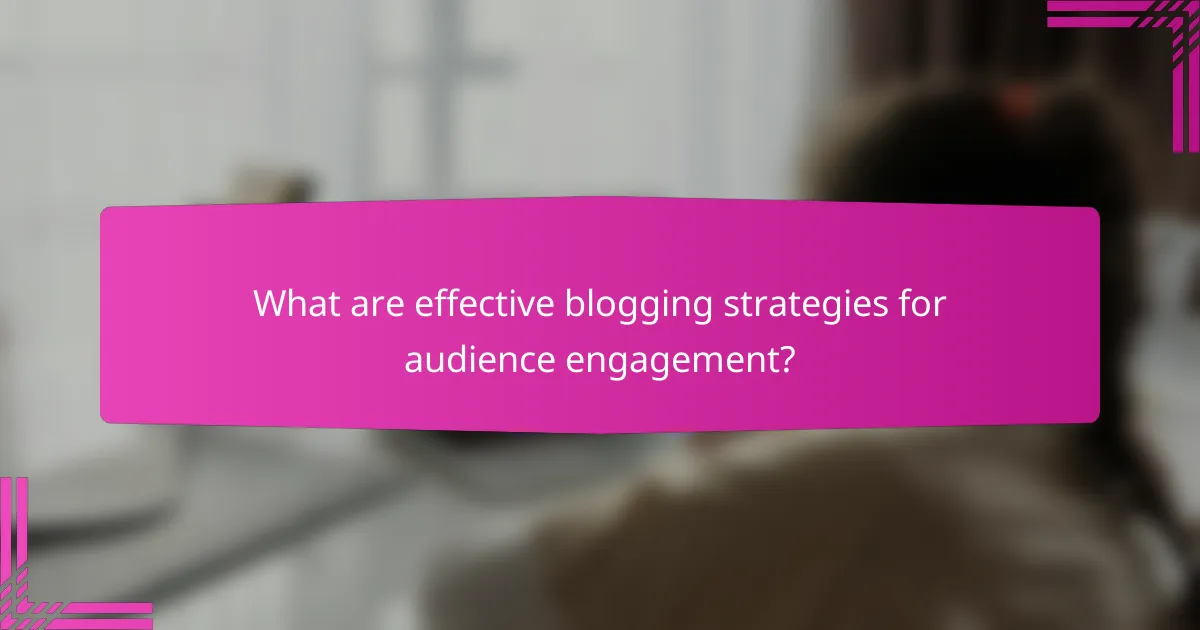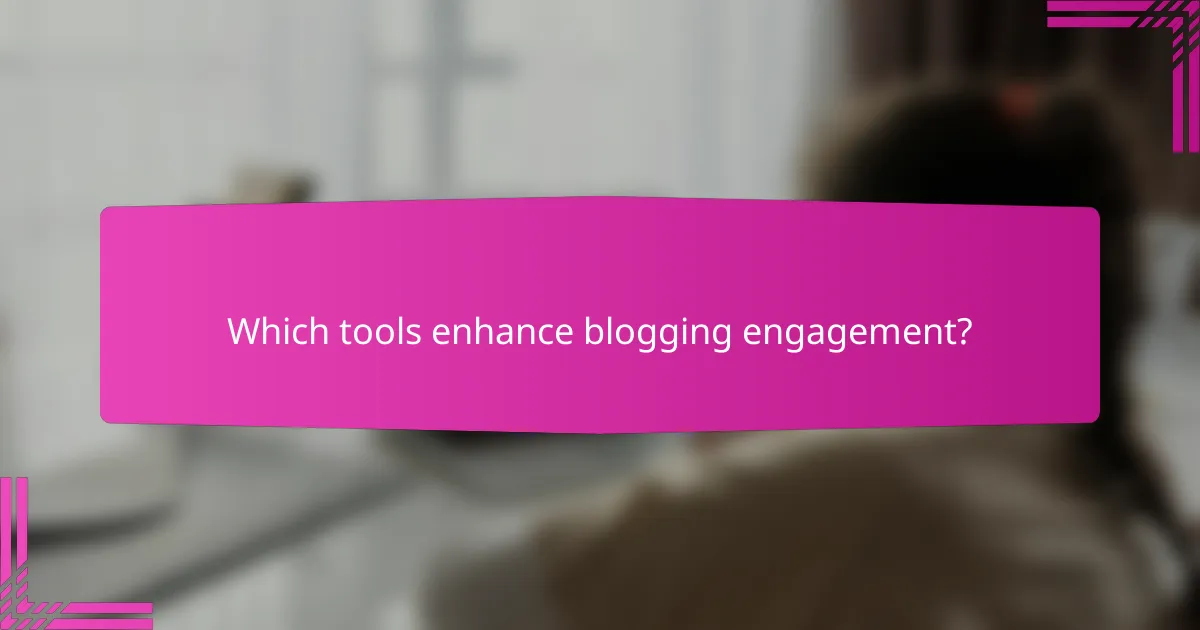Creating a blog that truly resonates with your audience in Australia means weaving in local stories and inviting them to join the conversation. By adopting a conversational tone and sharing personal experiences, you can foster a sense of community and connection. Plus, leveraging the right tools can elevate your content, making it more engaging and visually appealing for your readers.

How can you engage your audience in Australia?
Engaging your audience in Australia requires a mix of relatable content, local flavor, and interactive elements. By focusing on storytelling, incorporating local references, and encouraging interaction, you can create a vibrant community around your blog.
Use relatable storytelling
Storytelling is a powerful tool for engaging your audience. Share personal anecdotes or experiences that resonate with your readers’ lives, making your content more relatable and memorable. For instance, discussing everyday challenges or triumphs can foster a deeper connection.
Consider using local settings or familiar scenarios in your stories. This not only makes your content more relatable but also helps readers visualize the narrative, enhancing their emotional investment in your blog.
Incorporate local references
Incorporating local references is crucial for connecting with an Australian audience. Mention popular local events, landmarks, or cultural references that your readers can relate to. This creates a sense of belonging and shows that you understand their context.
For example, referencing iconic Australian sports events, like the AFL Grand Final or the Sydney Festival, can spark interest and engagement. Tailoring your content to include local slang or expressions can also make your writing feel more authentic and engaging.
Encourage audience interaction
Encouraging audience interaction is essential for building a community around your blog. Ask open-ended questions at the end of your posts to invite comments and discussions. This not only boosts engagement but also provides valuable feedback and insights from your readers.
Consider hosting polls or surveys to gather opinions on relevant topics. This not only makes your audience feel valued but also helps you tailor future content to their interests. Additionally, responding to comments promptly can create a welcoming atmosphere that encourages ongoing dialogue.

What are effective blogging strategies for audience engagement?
Effective blogging strategies for audience engagement focus on creating relatable content that resonates with readers. By employing a conversational tone, asking open-ended questions, and sharing personal experiences, bloggers can foster a deeper connection with their audience.
Utilize conversational tone
Using a conversational tone makes your blog feel more approachable and relatable. Write as if you are having a friendly chat with your readers, using simple language and an informal style. This helps to break down barriers and encourages readers to engage with your content.
To achieve this, consider using contractions, direct address (like “you” and “we”), and even humor where appropriate. For example, instead of saying “One should consider the following,” you might say, “You might want to think about these tips.” This shift creates a more inviting atmosphere.
Ask open-ended questions
Open-ended questions invite your readers to share their thoughts and experiences, fostering a sense of community. Instead of asking questions that can be answered with a simple “yes” or “no,” encourage deeper responses by asking questions like, “What challenges have you faced in your blogging journey?”
Incorporate these questions throughout your posts, especially at the end, to prompt comments and discussions. This not only boosts engagement but also provides valuable insights into your audience’s preferences and interests.
Share personal experiences
Sharing personal experiences adds authenticity to your blog and helps readers connect with you on a human level. When you share your own stories, struggles, and successes, it makes your content more relatable and encourages readers to engage with your narrative.
For instance, if you’re writing about overcoming writer’s block, share a specific moment when you faced that challenge and how you dealt with it. This not only makes your advice more credible but also invites readers to share their own stories, enriching the conversation.

Which tools enhance blogging engagement?
Several tools can significantly boost blogging engagement by improving content quality, generating ideas, and enhancing visuals. Utilizing the right resources can make your blog more appealing and interactive for readers.
Use Grammarly for tone checks
Grammarly is an essential tool for ensuring your writing maintains the right tone and clarity. It checks for grammatical errors, but it also offers suggestions on style and tone, helping you connect better with your audience.
When using Grammarly, pay attention to the tone detector feature, which indicates whether your writing is formal, informal, or neutral. Adjust your content accordingly to match your target audience’s preferences.
Employ BuzzSumo for content ideas
BuzzSumo is a powerful tool for discovering trending topics and popular content in your niche. By analyzing what resonates with readers, you can generate fresh ideas that are more likely to engage your audience.
To use BuzzSumo effectively, enter keywords related to your blog’s focus and review the top-performing articles. This will help you identify themes and formats that attract attention, allowing you to tailor your content strategy.
Incorporate Canva for visuals
Canva is a user-friendly design tool that enables you to create eye-catching visuals for your blog. Engaging images, infographics, and social media graphics can enhance your posts and keep readers interested.
When designing with Canva, consider using templates that align with your blog’s branding. Consistent visuals can strengthen your identity and make your content more shareable across platforms.

How does SEO impact audience engagement?
SEO significantly enhances audience engagement by improving how easily users can find your content online. When your site ranks higher in search results, it attracts more visitors, leading to increased interaction and retention.
Improves visibility in search results
Effective SEO practices boost your content’s visibility in search engines, making it more likely that users will encounter your site. By optimizing keywords, meta tags, and descriptions, you can improve your rankings on platforms like Google.
Consider focusing on long-tail keywords that match user intent. For instance, instead of targeting a broad term like “shoes,” use “best running shoes for flat feet” to attract a more specific audience.
Increases organic traffic
Higher visibility directly correlates with increased organic traffic, which refers to visitors arriving at your site through unpaid search results. This traffic is often more valuable, as these users are actively seeking information related to your content.
To maximize organic traffic, regularly update your content and ensure it remains relevant. Aim for a balance between evergreen content and timely posts to keep your audience engaged over time.
Enhances user experience
SEO not only focuses on keywords but also on improving the overall user experience. A well-structured site with fast loading times and mobile optimization keeps visitors on your page longer, reducing bounce rates.
Implementing clear navigation and engaging visuals can further enhance user experience. Consider using tools like Google PageSpeed Insights to identify areas for improvement and ensure your site meets user expectations.

What metrics measure audience engagement?
Audience engagement can be measured through various metrics that indicate how well your content resonates with readers. Key metrics include comments, shares, time spent on the page, and bounce rates, each providing insight into different aspects of user interaction.
Track comments and shares
Comments and shares are direct indicators of how engaged your audience is with your content. A high number of comments suggests that readers are not only consuming your content but also willing to discuss it, while shares indicate that they find it valuable enough to recommend to others.
To effectively track these metrics, use social media analytics tools and comment tracking features on your blog. Aim for a consistent increase in both metrics over time to gauge growing interest and engagement.
Analyze time spent on page
Time spent on a page is a crucial metric that reflects how captivating your content is. If users are spending several minutes reading your articles, it indicates that they find the material engaging and relevant.
Tools like Google Analytics can help you monitor this metric. A general rule of thumb is that a time spent of 2-3 minutes is a good sign, while anything less might suggest that your content isn’t holding attention. Consider improving content quality or layout if you notice low engagement times.
Monitor bounce rates
Bounce rates measure the percentage of visitors who leave your site after viewing only one page. A high bounce rate often indicates that users did not find what they were looking for or that the content did not meet their expectations.
To keep bounce rates low, ensure that your content is relevant and engaging right from the start. Aim for a bounce rate below 40% for optimal engagement, and consider using internal links to guide readers to more content on your site.



